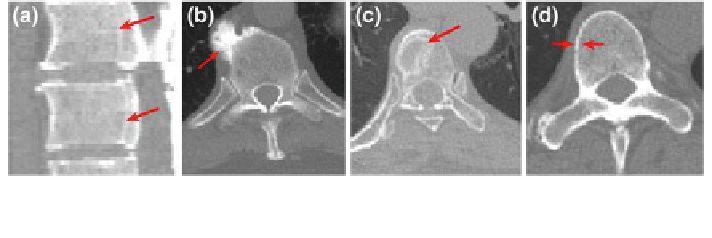Information Technology Reference
In-Depth Information
Fig. 2 Typical challenges for vertebrae segmentation. a Inner boundaries. b Osteophytes. c Bone
degenerative disease. d Double boundary
The literature is rich with organ segmentation techniques. However, we will
discuss only some of these techniques whose basics depend on shape modeling and
whose application is VB segmentation. To tackle the problem of segmenting a spine
bones, various approaches have been introduced. For instance, Klinder et al. [
1
]
developed an automated model-based vertebra detection, identi
cation and seg-
mentation approach. Kang et al. [
2
] developed a 3D segmentation method for
skeletal structures from CT images. Their method starts with a three dimensional
region growing step using local adaptive thresholds. Then a closing of boundary
discontinuities and an anatomically-oriented boundary adjustment steps are done.
They presented various anatomical bony structures as applications. They evaluated
their segmentation accuracy using the European Spine Phantom (ESP) [
3
]. In order
to measure bone mineral density, Mastmeyer et al. [
4
] presented a hierarchical
segmentation approach for the lumbar spine. They reported that it takes less than
10 min to analyze three vertebrae, which is a huge improvement compared to what
is reported in [
5
]: 1
2 h. However, this timing is far from the real time required for
clinical applications. To analyze the fracture of VBs, Roberts et al. [
6
] used the
active appearance model. Other techniques have been developed to segment skel-
etal structures and can be found for instance in [
7
-
9
].
Actually, there are a huge number of segmentation techniques in the literature:
simple techniques (e.g. region growing or thresholding), parametric deformable
models and geometrical deformable models. However, all these methods tend to fail
in the case of noise, gray level inhomogeneities, and diffused boundaries. Organs
have well-constrained forms within a family of shapes. Therefore segmentation
algorithms have to exploit the prior knowledge of shapes and other properties of the
structures to be segmented. Leventon et al. [
10
] combined the shape and deformable
model by attracting the level set function to the likely shapes from a training set
speci
-
ed by principal component analysis (PCA). To make the shape guides the
segmentation process, Chen et al. [
11
]de
ned an energy functional, which basi-
cally minimizes an Euclidean distance between a given point and its shape prior.
Huang et al. [
12
], combined registration with segmentation in an energy minimi-
zation problem. The evolving curve is registered iteratively with a shape model

